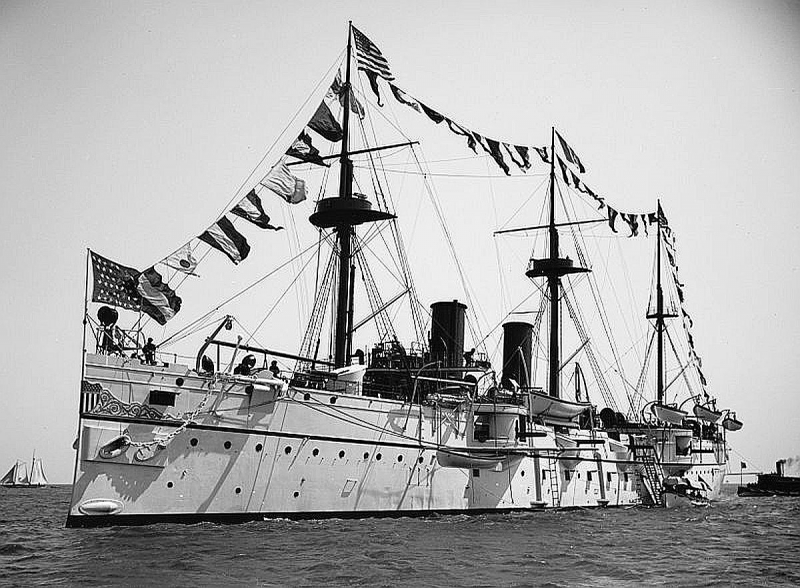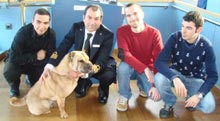| Precedente Successiva |
 |
| USS San Francisco |
| Name: USS San Francisco Namesake: San Francisco, California Builder: Union Iron Works, San Francisco, California Launched: 26 October 1889 Commissioned: 15 November 1890 Decommissioned: 25 October 1898 Recommissioned: 2 January 1902 Decommissioned: 31 December 1904 Notes: Converted to "mine planter" June 1908 Recommissioned: 29 November 1911 Decommissioned: 6 June 1916 Recommissioned: 18 October 1916 Reclassified: Minelayer (CM-2), 17 July 1920 Decommissioned: 24 December 1921 Renamed: USS Tahoe (CM-2), date unknown (post-1921) USS Yosemite 1 January 1931 Struck: 8 June 1937 Fate: Sold for scrapping 20 April 1939 General characteristics Type: Protected cruiser. Minelayer Displacement: 4,088 tons Length: 324 ft 6 in (98.91 m) Beam: 49 ft 2 in (14.99 m) Draft: 18 ft 10 in (5.74 m) Speed: 19 kn (35 km/h; 22 mph) Complement: 384 officers and men Armament: As Built: 12 ? 6 in (150 mm)/30 cal Mark 3 guns (12x1) 4 ? 6-pounder (57 mm (2.2 in)) guns (4x1) 4 ? 3-pounder (47 mm (1.9 in)) guns (4x1) Converted to Minelayer: 4 ? 5 in (130 mm) guns 2 ? 1-pounder guns 2 ? machine guns 300 Mark II naval mines The first USS San Francisco (C-5/CM-2) was a steel protected cruiser in the United States Navy. She was later named Tahoe and then Yosemite, becoming the third U.S. Navy ship to bear the name Yosemite. San Francisco was launched on 26 October 1889 at the Union Iron Works, San Francisco, California; sponsored by Miss Edith W. Benham; and commissioned on 15 November 1890, Captain William T. Sampson in command. Service history Pre-Spanish-American War Assigned to the South Pacific Squadron, San Francisco moved south and became the squadron's flagship on 31 March 1891. Five months later, as an eight-month-old civil war drew to a close in Chile, she landed a force of sailors and Marines to protect the United States Consulate. September brought an end to the war, and San Francisco resumed her cruising off the South American coast. With the new year, 1892, she sailed north and west and arrived at Honolulu on 27 February as political differences deepened between monarchists and republicans. She departed Hawaii in August 1892, en route to Norfolk, Virginia, where she arrived in February 1893. San Francisco became the flagship of the North Atlantic Squadron on 31 May and cruised off the New England coast into the fall. In November, she sailed south, visited ports in the Caribbean; and, in late December, reached Rio de Janeiro and assumed flagship duties for the South Atlantic Squadron. She called at ports in Brazil, the Netherlands West Indies, Colombia, Costa Rica, and Nicaragua during the next six months, then returned to the United States, anchoring at New York on 29 July 1894. Spanish-American War The year 1895 brought further overseas duty; and, in January, San Francisco crossed the Atlantic to cruise in the eastern Mediterranean Sea as political tension within the Ottoman Empire caused diplomatic uneasiness. Later shifted to other areas, she remained in European waters until 1896. In March of that year, she returned to the U.S.; cruised off the east coast until the outbreak of war against Spain in April 1898; then took up patrol duties along the Florida coast and off Cuba. In July, Spain requested terms; and, in August, she returned to Hampton Roads. She was placed out of commission at the Norfolk Navy Yard on 25 October. Pre-World War I Recommissioned on 2 January 1902, San Francisco was again assigned to the European Squadron. In September, she returned to the U.S. and commenced operations southward into the Caribbean. Another cruise to the Mediterranean, thence on to Asiatic ports, followed; and, in the fall of 1904, the protected cruiser again entered the Norfolk Navy Yard, where she was decommissioned on 31 December. In June 1908, San Francisco was ordered refitted as a minelaying vessel. On 21 August 1911, she was recommissioned but retained in reserve; and, after participation in the Fleet Review at New York, she was placed in full commission on 29 November. Designated a mine planter on 19 December 1912, she remained based at Norfolk and operated in the western Atlantic and the Caribbean into 1916, when she was again ordered inactivated. She was placed in reserve at Portsmouth, New Hampshire, on 6 June 1916, but resumed full commissioned status again on 18 October. World War I With the April 1917 entry of the United States into World War I, San Francisco began laying antisubmarine nets in the Hampton Roads area. In June, she shifted to New York, where she conducted experimental deep water minelaying operations; and, during August, she underwent overhaul at the Portsmouth Navy Yard. In mid-September, she moved back down the coast to New London, Connecticut where she provided net laying services until ordered to Norfolk for training duty later in the fall. From December 1917-March 1918, she underwent an extensive overhaul; and, in April, she became flagship of Mine Squadron 1. In early May, the squadron assembled at Newport, Rhode Island. On the 12th, the ships sailed for England. On the 26th, units of the Royal Navy escorted the ships into Inverness. San Francisco joined the Allied effort of creating the North Sea Mine Barrage across the North Sea to restrict German submarine traffic into the Atlantic by: ? planting 153 mines during the 1st minelaying excursion on 7 June, ? planting 170 mines during the 3rd minelaying excursion on 14 July, ? planting 170 mines during the 4th minelaying excursion on 29 July, ? planting 170 mines during the 5th minelaying excursion on 8 August, ? planting 166 mines on 12 August to field test sensitivity settings for the antenna fuze detonating relay of the Mk 6 mines, ? planting 160 mines during the 6th minelaying excursion on 18 August, ? planting 170 mines during the 7th minelaying excursion on 26 August, ? planting 170 mines during the 8th minelaying excursion on 7 September, ? planting 170 mines during the 9th minelaying excursion on 20 September, ? planting 170 mines during the 10th minelaying excursion on 27 September, ? planting 170 mines during the 11th minelaying excursion on 4 October, ? planting 170 mines during the 12th minelaying excursion on 13 October, and ? planting 170 mines during the final 13th minelaying excursion on 24 October. ? Inter-war period San Francisco conducted minelaying operations until the Armistice on 11 November. Minesweepers then moved in, and she prepared to return home. She departed Inverness on 2 December and arrived in Hampton Roads on 3 January 1919. Overhaul followed, after which she cruised in the western Atlantic and Caribbean through 1921. Designated CM-2 on 17 July 1920, she was ordered inactivated in 1921; and on 6 October, she arrived at Philadelphia where she was decommissioned on 24 December 1921. Remaining in reserve through the decade, CM-2 was renamed Tahoe, and then Yosemite, effective 1 January 1931, to allow the name San Francisco to be given to CA-38, then under construction. As Yosemite, she remained at Philadelphia for another eight years. Her name was struck from the Naval Vessel Register on 8 June 1937, but she was retained at the Navy Yard until sold for scrapping to the Union Shipbuilding Company, Baltimore, Maryland on 20 April 1939. |
| Username | |
| Armatore | USA Navy |
| Ship manager | |
| Numero IMO | |
| Classificazione | Cruiser |
| Cantiere e anno di costruzione | 1890 Union Iron Works, San Francisco, California |
| Data | |
| Luogo | |
| Aggiunta il | 26/10/2014 |
| Dimensioni | 1200 x 881 |
| visite | 1819 |
















